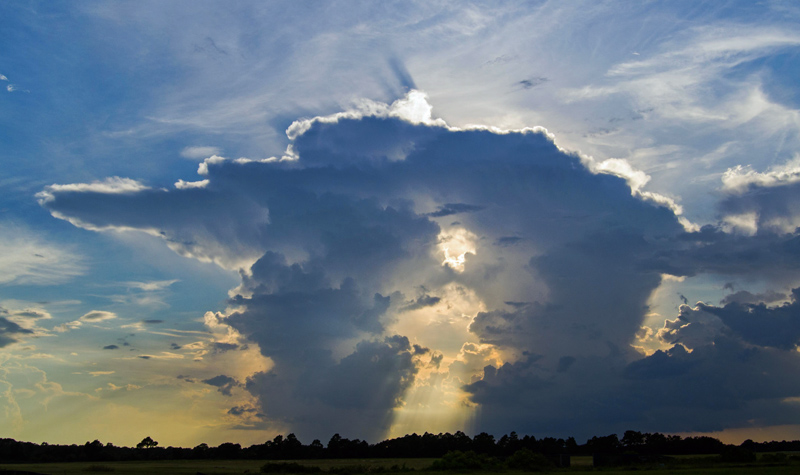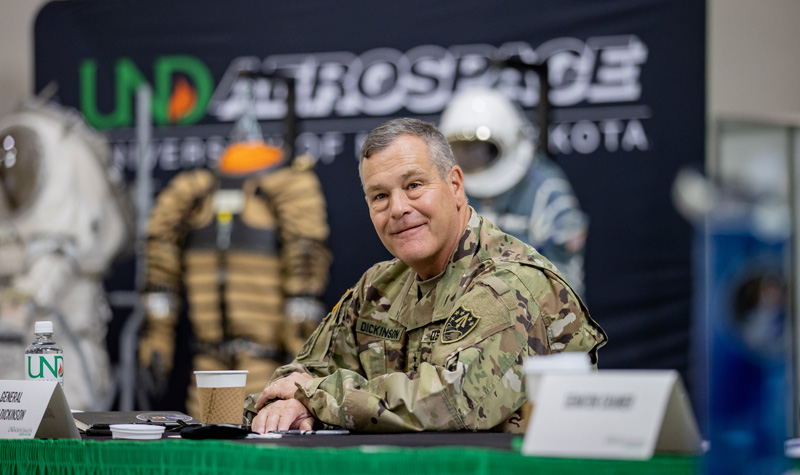‘Un-manned U’ (By David Dodds, UND Public Affairs – 08/29/16)
UND is the epicenter of a regional engine that’s leading the world in drone innovation, education, training and research
Call it the Valley of the Drones.
A narrow swath straddling North Dakota’s eastern border, anchored by Grand Forks to the north and Fargo to the south, the Red River Valley of the North has long been known for having some of the richest agricultural land in the world. These days, however, it’s making a big name for itself as a fertile bed in the surging global unmanned aircraft systems (UAS) industry.
And the University of North Dakota is well positioned in this enviable sweet spot as the central hub to it all.
Such was the message pounded home at the 10th Annual UAS Summit & Expo, held recently at the Alerus Center in Grand Forks.
If you’re looking to make a name for yourself in the multi-billion-dollar-and-growing economy that is UAS: Get to know UND and its long list of regional partners that, when combined, just might be the “Silicon Valley for Drones” as dubbed by the New York Times.
Thriving ‘ecosystem’
Luke Giever, program director for the summit, likened the perfect “ecosystem” for UAS development that surrounds UND and Grand Forks to what exists in Nashville with country music and to what Daytona, Fla., has with NASCAR.
“Grand Forks has become a destination that’s very unique and very important to the UAS industry,” said Geiver, who also serves as editor of UAS Magazine, which has hosted the UAS Summit since its fledgling inception in 2006.
That first summit was more of a roundtable comprising a handful of industry pioneers and government contractors. Attendance at the latest gathering numbered in the hundreds, attracting representatives in commercial; military; local, state and federal government; academia and big utility fields, to name a few.
Ecosystem was the buzzword throughout the summit, as in North Dakota harbors an ecosystem where UAS development not only survives — it thrives.
That’s because of the legwork done at UND as far back as John D. Odegard, the pioneering founder of UND famed aviation school, now regarded among the largest and best in the world. Odegard set in place the cornerstone on which the future of aviation education, training and research could flourish at UND.
Series of firsts
In 2005, when the UAS economy was ready to take off, UND and its John D. Odegard School of Aerospace Sciences were well poised to pilot the way to the top. It wouldn’t be long before the state of North Dakota would supply the funding and other support to make UND a Center of Excellence in drone education, training and research to continue its position as an industry leader.
UND established the first-in-the-nation UAS degree program in 2009. Since then, the program has sent more than 100 UAS-specialized graduates into the workforce to support industry growth, and in some cases, to start their own UAS-related businesses. The program has more than 200 UAS majors enrolled this fall semester.
The list of UAS firsts continued at UND after it launched its UAS research ethics and privacy committee to probe the murky areas of this undefined and untested strange new paradigm in research.
Just last month, UND cut the ribbon on the largely privately-funded Robin Hall, a first-of-its-kind-anywhere university building dedicated to UAS education and research.
And this week, the UND College of Business and Public Administration (CoBPA) launched the nation’s first business program dedicated to UAS entrepreneurship. The course is being team-taught by Matt Dunlevy, a UND alum and President/CEO of SkySkopes, a growing regional UAS business; and Rick Thomas, a well-known expert on the UAS industry and the Global Hawk UAS platform.
UND’s Center for Innovation, a business incubator and investment hub that is part of the CoBPA, already holds the distinction of housing the most UAS entrepreneurs and startups in the nation.
Place to be
When it comes to its UAS endeavors, UND collaborates with North Dakota University System partners such as North Dakota State University in Fargo (80 miles to the south ) and Lake Region State University in Devils Lake (90 miles to the west). UND is working with NDSU on UAS-related research in precision agriculture and cybersecurity initiatives, while Lake Region State maintains a growing UAS Law Enforcement program.
In another part of the Red River Valley, UND maintains close ties with Northland Community and Technical College of East Grand Forks and Thief River Falls. Northland focuses on training UAS pilots and maintenance specialists.
UND and its UAS enterprise also benefit from having a huge regional partner only 15 miles west on U.S. Highway 2: the Grand Forks Air Force Base, which is one of the foremost bases for the U.S. Air Force’s UAS fleet. UND and Grand Forks’ proximity to the vast and largely unmanned U.S.-Canadian border make it a no-brainer that the University would work in close cooperation with UAS operations of the U.S. Customs and Border Protection and the Grand Forks County Sheriff’s office, the latter of which, maintains the largest UAS fleet of any other sheriff’s office in the nation.
All of this regional UAS activity paved the way for another big development in the area with the advent of Grand Sky. Grand Sky is a Grand Forks County UAS initiative, with multiple public and private sector partners, to put a fully operational UAS business park on land adjacent to the Grand Forks Air Force Base for the purpose of attracting private-sector UAS developments and startups. Anchor tenants and UAS industry giants Northrop Grumman and General Atomics already are on board and bring a sense of legitimacy to the new business park.
Still another feather in North Dakota’s UAS cap, and arguably the biggest, came in 2013 with the onset of the Northern Plains UAS Test Site, headquartered at UND. The Test Site is one of six established in the United States by the Federal Aviation Administration to collect data for the FAA on all things UAS. It also serves as a “gateway for industry” to operate and conduct research in air space that is less restricted than typical general and commercial aviation zones.
With all these assets in one location, it’s no wonder the attention of the UAS world is so squarely focused on UND and its partners.
“This isn’t some fly-by-night operation,” said U.S. Sen. John Hoeven, R-N.D., “This is the place to be if you want to partner with someone or innovate unmanned aircraft systems.”
Cross-campus research
Even John Cavolowsky, NASA director of airspace operations and safety, the man who’s tasked with finding the right balance for manned and unmanned aviation to co-exist as seamlessly as possible, is impressed with synergies that exist within UND’s UAS ecosystem.
“There is an enormous center of gravity here for us to be a part of,” he said.
North Dakota Lt. Gov. Drew Wrigley, who, among his other duties oversees the Northern Plains UAS Test Site, says the state has been “fiercely committed” to providing grant opportunities to people who want to partner on UAS initiatives in the state. He added that the state has pumped in more than $34 million over the years through the Center of Excellence at UND and the Test Site to spur more of these private-public investments in UAS.
New UND President Mark Kennedy said his University already is on to next steps in addressing some of the most critical challenges in the UAS industry through its cutting-edge research. UND has teams looking at ways for UAS to more effectively fly beyond visual lines of sight with enhanced “see and avoid” technology as well as converting the vast amounts of data collected by UAS sensors into timely, accurate and relevant information.
He dubbed the University as, among other things, “Un-manned U.”
“In addition to being the Silicon Valley of UAS, we also want to be the premier university in research of UAS,” said Kennedy, who also took part in the summit.
But Kennedy also wants to see UAS research transcend the Aerospace School and College of Engineering – where the majority of UAS research activity takes place on campus — and spill over to other academic disciplines.
UND Vice President for Research and Economic Development Grant McGimpsey echoed Kennedy’s call for UND to conduct cross-disciplinary research across its campus to benefit industries and institutions important to life in North Dakota. This kind of research could be applied in everything from energy exploration and development to advances in sensor technology in the field of medicine.
“This is just the beginning for us,” he said. “There’s a lot of things that we do at UND that can helped through the use of UAS but there’s also a lot of things at UND that can help UAS become a more effective tool.”
McGimpsey said UND also will continue to be active in partnering with private-sector UAS companies through the University’s Corporate Engagement Group. He said Northrop Grummon Corp. was one of the first big accounts that the group pursued. Working with the private-sector and UND’s existing regional UAS partners only enriches and strengthens UND research.
“We’re an important partner but we’re by no means the only one,” McGimpsey said.
When he sings the praises of partnering with UND on unmanned aircraft innovations his thoughts quickly jump to the future and other frontiers ripe for unmanned exploration such as the depths of the world’s oceans and the polar regions. The work happening in places like UND and North Dakota, in the realm of aviation, could only help efforts with these future applications, he says.
He said most communities would love to have two or three things in place like what exist around Grand Forks in area of UAS development.
“You have all of them,” Jaggers said while addressing a Summit gathering. “I can’t think of a better place I’d rather be than up here in Grand Forks.”


